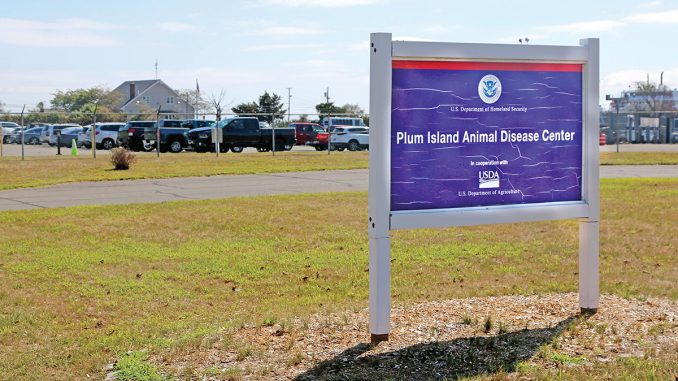
Local stakeholders have called for more extensive review of Plum Island as the federal government looks to pack up and relocate labs to Manhattan, Kan.
The federal government put Plum Island up for sale in 2008, putting the land at risk of development. Plum Island was taken off the auction block in 2020, although the site is still for sale to government agencies. The Department of Homeland Security plans to finish closing the Plum Island Animal Disease Center in 2028 at a cost of $150 million.
In comments included in a recently released draft environmental assessment, concerns focused on expanding the analysis to include the entire island and potential impacts to federally threatened and endangered species on the island. Concerns were also expressed about the preservation of cultural resources, and minimizing impact to the island ecosystem during decontamination efforts.
“The notice is narrowly focused on the major lab buildings, two of the Fort Terry buildings not included in the [Plum Island Animal Disease Center] Historic District, and the Orient Point facility, which is vital for the ferry connection to Plum Island from the Long Island mainland,” a letter signed by members of the Suffolk County Legislature said. “We believe the Environmental Assessment should consider the impacts of the closure of PIADC to the entire island and all its components.”
The legislature adds that there is “strong interest in the future of Plum Island” among stakeholders in the southern New England region and expresses hope that “the federal government will clarify its process and engage communities in a broader dialogue about the island’s future than your notice implies.”
“There are numerous aspects of Plum Island and its structures that need to be examined and discussed. The island is a unique treasure, the permanent preservation of which we fully support for a number of reasons, including benefits to the region’s people, economy, and terrestrial and marine environments,” the county legislature adds.
The North Fork Audubon Society, North Fork Environmental Council, The Nature Conservancy and Save the Sound expressed similar sentiments in separate letters. Save the Sound additionally requested clarification on shutdown procedures, including plans for the safe transport of “viruses, vaccines, and other materials” to the new facility in Kansas.
Environmental groups and other stakeholders have previously made a case for preserving the 840-acre island as a national monument, arguing its ecological, cultural and historic significance. A 2020 report from the Preserve Plum Island Coalition details a vision for a 640-acre preserve, 125-acre research complex and a small museum highlighting the island’s heritage and history. The Preserve Plum Island Coalition has secured a potential donor who is willing to fund management of the island if the acreage is conserved. Both Connecticut and New York lawmakers have indicated support for the coalition.
The proposed action described in the recently released draft environmental assessment includes decontamination plans for biocontainment facilities. No facility construction or demolition would occur. The assessment notes that DHS has worked closely with the state and Suffolk County over the past three decades “to investigate and successfully remediate numerous sites of concern.”
The state Department of Environmental Conservation has determined that 10 sites of concern on Plum Island require further action. Some physical assets, such as emergency generators and boilers, would be put into long-term storage.
Approximately 100 support staff currently employed at Plum Island and the Orient Point facility would continue to support closure activities until the move is complete. DHS plans to employ approximately 200 additional contractors to help with the shutdown, after which no DHS personnel would work at the facility. The analysis conclusion notes that no significant adverse impact to the environment is expected from the proposed action.
The most recent biodiversity survey, conducted by the New York Natural Heritage Program in 2015, identified over 200 species of birds, over 200 species of moths, nine mammals and five reptiles on Plum Island, along with occasional white-tailed deer, raccoons and eastern box turtles. Save the Sound has sponsored further underwater investigation of the island, including a dive last August. The island is also the largest resting place, or haul out area, for seals in New York. Eighty-five percent of the site is undeveloped.
The Plum Island Lighthouse, built in 1869, is on the National Register of Historic Places. Fort Terry was established on the island in 1897 as part of coastal fortifications related to the Spanish-American War, and is also on the National Register of Historic Places.
The Antiquities Act of 1906 authorizes the president to establish national monuments on sites with “historic landmarks, historic and prehistoric structures, or other objects of historic or scientific interest,” according to the National Park Service website.
Southold Town adopted local zoning for the federally owned Plum Island in 2013, with one area allocated for research and the other set as a conservation district that prohibits development on 600 acres. The Plum Island ferry dock was also zoned. Under Southold town code, Marine III permits ferry terminals for ferry service to and from Plum Island only, with some accessory uses. The Suffolk Times has previously reported the rezoning was part of efforts to preserve the island.

